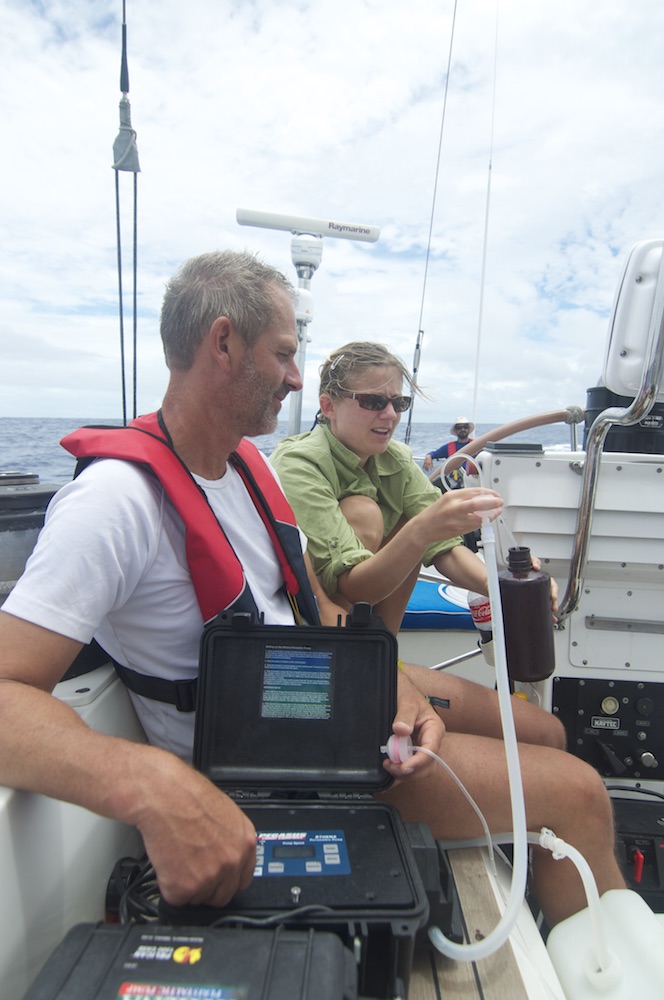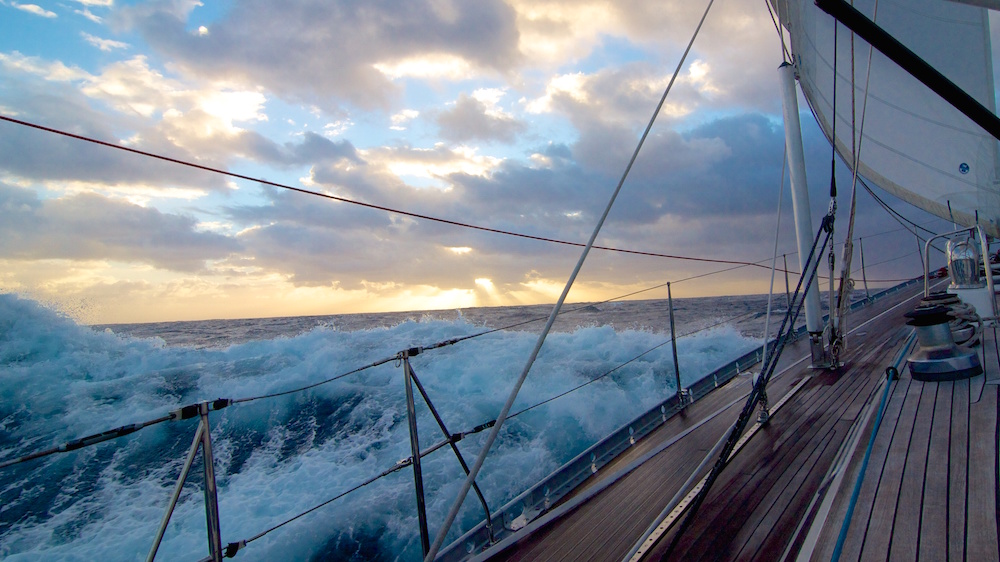Citizen Oceanography Meets the Marine Microbiome
February 9, 2015
By Rachelle Lauro of Indigo V Expeditions (new Mission Blue partners)
When we think of the ocean, often times it’s the more exciting and interactive denizens of the sea that come to mind. We can easily connect with the plight of cetaceans in captivity, monitor bycatch, track orca populations and lobby against shark culls.
It’s hard to believe, but the ocean could be completely devoid of macro-life, yet continue to serve its main function of atmospheric buffering, nutrient cycling, CO2 absorption and oxygen production. Taken in sum, the ocean is the backbone to sustaining habitable living conditions on earth.
A healthy ocean ecosystem underpins healthy life on land, national security and business interests for humankind. Yet we continue our assault on this very fragile ecosystem with no real information on the effects of our activities. As world population grows, the pressures we put on the ocean will only increase. Overfishing, toxic dumping, micro-plastic contamination and deep sea drilling all contribute to the destabilization of this increasingly fragile system. We are seeing the rise of ocean dead zones, acidification and the loss of big fish.
While the effects on marine fauna can be readily seen, measured and monitored, the biggest threat is to the invisible majority: microbes.
What is the Marine Microbiome and Why Does it Matter?
Marine bacteria and viruses, collectively known as the marine microbiome, can be likened to human gut flora constantly maintaining health on a molecular level. Scientists estimate that there are several hundred to several hundred thousand different species of microbes per ml of seawater and can number up to a million.1,2 They also product much of the world’s oxygen by photosynthesis and serve as the bedrock for the food web. Microbes are also the first to respond to changes in ocean chemistry. Because of this sensitivity, we can liken them to the proverbial “canary in the coalmine.”

Microbes are adapted to different physical parameters (e.g. temperature, salinity and pressure). Temperature is a major factor to the distribution and structure of the most abundant marine bacteria, including those that photosynthesize and convert CO2 into oxygen.
An appreciable change in ocean chemistry and temperature would alter microbial community structures throughout the ocean, leaving microbes highly susceptible to extinction. It is widely accepted that a new community of microbes could adapt to fill the void, but this shift would result in a change of nutrients available in the food web, leaving food security and the future of marine life very much in question.
Any substantial change to the existing structure of marine microbial communities would also affect the ocean circulation system that could, in turn, change the carbon cycle of the whole planet. Perhaps now, more than ever, monitoring the world’s ocean is of urgent priority.
However, because the ocean is dynamic and tremendously vast, millions of observation points are required to monitor the marine environment over years. Traditional oceanographic research vessels are unable to meet this demand. Oceanography research is restricted to large and expensive research ships where only a few samples may be taken at a time. A modern research vessel typically costs more than $30,000 per day to operate and cover a fraction of area.3
To put things in perspective, consider the following: During a continuous year at sea, without stopping for fuel or crew change, a single research vessel could cover approximately 3% of the ocean. Despite covering an enormous area – 9.7 million km2, calculated from the Goode Homolosine projection – it would cost at least $15 million to sustain the voyage and research.3
Twenty vessels would be required to effectively cover the region between both tropical latitude lines. The carbon footprint of these activities would be enormous. The costs would exceed $300 million dollars per year, and would exclude high latitude regions.3
With carbon levels climbing and severe weather events becoming more frequent, now more than ever, we need an innovative solution to this complex problem.
Citizen Oceanography
Public involvement in scientific research and discoveries has a long, rich tradition. Gregor Mendel, an Augustinian friar, discovered the basis of genetic inheritance while working in the garden of his monastery. Michael Faraday, self-taught, laid the foundation of electromagnetic induction while working as an apprentice bookbinder and bookseller. Arguably the most famous “citizen oceanographer” was Charles Darwin, who had very little formal training in biology. Leonardo da Vinci painted portraits for income while pursuing science in his spare time. His hobby led to some of the greatest discoveries in history.

Despite this long history, the involvement of ‘amateurs’ in science faded. As the 20th Century dawned, science was relegated to well-funded “elitist” laboratories that we see today leading to the growing separation between the public and science. In the last few years, mostly due to technological breakthroughs, we have witnessed revitalization in the participation of civilians in science.
By extending the concept of citizen science to oceanography, we could continually monitor the world’s oceans for a fraction of the costs using traditional methods. By putting data collection in the hands of “citizen oceanographers,” we can dramatically reduce the cost per sample collected, which means more information can be gathered per research dollar spent.
The concept of crowd-sourced oceanography can solve the great data collection bottleneck. Joining cost-effective cutting edge technology with existing world cruiser routes, we can monitor microbial communities in the world’s oceans year after year in the same locations. This is crucial to building a baseline of ocean health that will lead to the scientific management of our oceans and fisheries, leading to the preservation of the global ocean for generations to come.

About Indigo V Expeditions:
Indigo V Expeditions is non-profit consortium of leading oceanographers from around the world, whose network of “citizen oceanographers” help close the existing data gap by collecting data along cruising routes. The resulting models will be used to raise public awareness and assist policymakers to make better scientifically-based decisions that will lead to the protection of our global ocean.
For more information about our program, or to volunteer as a citizen oceanographer, please visit: www.indigovexpeditions.com.
References:
- Curtis T.P., Sloan W.T., Scannell J.W. 2002. Estimating prokaryotic diversity and its limits. Proc Natl Acad Sci USA. 99:10494–10499.
- Huber J.A., Welch D.B.M., Morrison H.G., Huse S.M., Neal P.R., Butterfield D.A., et al. 2007. Microbial population structures in the deep marine biosphere. Science. 318:97–100.
- Lauro FM, Senstius SJ, Cullen J, Neches R, Jensen RM, et al. 2014. The Common Oceanographer: Crowdsourcing the collection of oceanographic data. PLoS Biol 12(9): e1001947.









Dear Mission Blue,
I am VERY interested in speaking with someone regarding the details for collection, sample processing, and what types of data you are aiming to produce. If you are thinking about sequencing your samples, we should talk! We are a collection of scientists trying to create a framework for microbial ‘omics analysis and it would be amazing if we could connect with you to develop use-cases that could work for your project and standardize the process so sampling – from your work, and from ours – could be comparable.
my background: linkedin.com/in/elishawc
Cheers,
-Elisha Wood-Charlson, PhD
Communication Project Manager
Dear Elisha,
Thank you for your interest in Indigo V Expeditions’ work. You can contact Rachelle Lauro directly at: Rachelle (at) indigovexpeditions (dot) com for more information on possibilities for collaboration.
Best of luck!